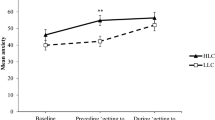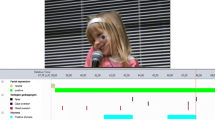Abstract
This study examined the discrepancy between self-established standards and self-efficacy in social situations. Socially anxious and nonanxious men rated a series of standards for judging the adequacy of their performance in an upcoming social interaction; subjects also rated their social self-efficacy, or perceived ability to handle the interaction. Nonanxious subjects expected their ability to equal or exceed all standards of evaluation. Anxious subjects expected their ability to equal that of the average subject and also believed their performance would match their personal standard. However, anxious subjects believed their social behavior would fall short of what they believed the experimenter expected of them. No support was found for the idea that socially anxious men establish perfectionistic standards. Rather, they believed that others held standards for them that they could not achieve. The results are congruent with cognitive theories of social anxiety.
Similar content being viewed by others
References
Ahrens, A. H., Zeiss, A. M. & Kanfer, R. (1988). Dysphoric deficits in interpersonal standards, self-efficacy, and social comparison.Cognitive Therapy and Research, 12, 53–67.
Alden, L., & Cappe, R. (1981). Nonassertiveness: Skill deficit or selective self-evaluation.Behavior Therapy, 12, 107–114.
Alden, L., & Safran, J. (1978). Irrational beliefs and nonassertive behavior.Cognitive Therapy and Research, 4, 357–364.
Alden, L. E., & Wallace, S. T. (1991), Social standards and social withdrawal.Cognitive Therapy and Research 15 85–100.
Arkin, R. M. (1981). Self-presentation styles. In J. T. Tedeschi (Ed.),Impression management in social psychological research (pp. 311–333). New York: Academic Press.
Arkin, R. M., Lake, E. A., & Baumgardner, A. H. (1986). Shyness and self-presentation. In W. H. Jones, J. M. Cheek, & S. R. Briggs (Eds.),Shyness: Perspectives on research and treatment (pp. 189–203). New York: Plenum Press.
Bandura, A. (1986).Social foundations of thought and action: A social cognitive theory. Englewood Cliffs, NJ: Prentice-Hall.
Bandura, A., & Cervone, D. (1986). Differential engagement of self-reactive influences in cognitive motivation.Organization Behavior and Human Decision Processes, 38, 92–113.
Beck, A., & Beamsdorfer, T. (1974). Assessment of depression: The Depression Inventory.Pharmacopsychiatry, 7, 151–169.
Buss, A. H. (1980).Self-consciousness and social anxiety. San Francisco: Freeman.
Cacioppo, J. T., Glass, C. R., & Merluzzi, T. V. (1979). Self-statements and self-evaluations: A cognitive-response analysis of heterosocial anxiety.Cognitive Therapy and Research, 3, 249–262.
Carver, C. S., & Scheier, M. F. (1985). Aspect of self, and the control of behavior. In B. R. Schlenker (Ed.),The self in social life (pp. 146–174). New York: McGraw-Hill.
Carver, C. S., & Scheier, M. F. (1986). Analyzing shyness: A specific application of broader self-regulatory principles. In W. H. Jones, J. M. Cheek, & S. R. Briggs (Eds.),Shyness: Perspectives on research and treatment (pp. 173–185). New York: Plenum Press.
Clark, J. V., & Arkowitz, H. (1975). Social anxiety and self-evaluation of interpersonal performance.Psychological Reports, 36, 211–221.
Fenigstein, A., Scheier, M. F., & Buss, A. H. (1975). Public and private self-consciousness: Assessment and theory.Journal of Consulting and Clinical Psychology, 43, 522–527.
Goldfried, M. R., & Sobocinski, D. (1975). Effect of irrational beliefs on emotional arousal.Journal of Consulting and Clinical Psychology, 43, 504–510.
Ingram, R. (1989). Affective confounds in social-cognitive research.Journal of Personality and Social Psychology, 56, 715–722.
Kendall, P. C., & Watson, D. (Eds.). (1989).Anxiety and depression: Distinctive and overlapping features. San Diego: Academic Press.
Leary, M. R. (1982). Social anxiety. In L. Wheeler (Ed.),Review of personality and social psychology (Vol. 3, pp. 97–120). Beverly Hills, CA: Sage.
Schlenker, B. R., & Leary, M. R. (1982). Social anxiety and self-presentation: A conceptualization and model.Psychological Bulletin, 92, 641–669.
Strauman, T. J. (1989). Self-discrepancies in clinical depression and social phobia: Cognitive structures that underlie emotional disorders?Journal of Abnormal Psychology, 98, 14–22.
Stravynski, A., & Shahar, A. (1983). The treatment social dysfunction in nonpsychotic outpatients: A review.Journal of Nervous and Mental Disease, 171, 721–728.
Watson, D., & Friend, R. (1969). Measurement of social-evaluative anxiety.Journal of Consulting and Clinical Psychology, 33, 448–457.
Author information
Authors and Affiliations
Additional information
This article is based on a master's thesis by the first author under the supervision of the second author. Preparation of this article was supported by a grant to the second author from the Social Sciences and Humanities Research Council of Canada. The first author was supported by fellowships from the Social Sciences and Humanities Research Council of Canada.
Rights and permissions
About this article
Cite this article
Wallace, S.T., Alden, L.E. A comparison of social standards and perceived ability in anxious and nonanxious men. Cogn Ther Res 15, 237–254 (1991). https://doi.org/10.1007/BF01173016
Issue Date:
DOI: https://doi.org/10.1007/BF01173016




